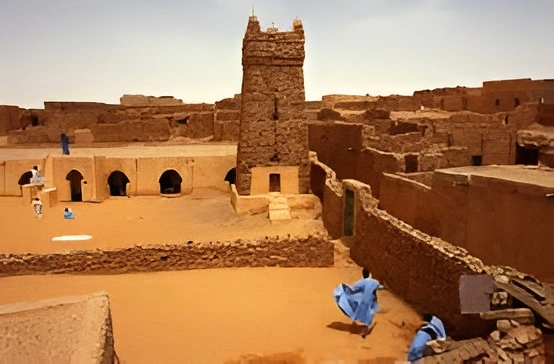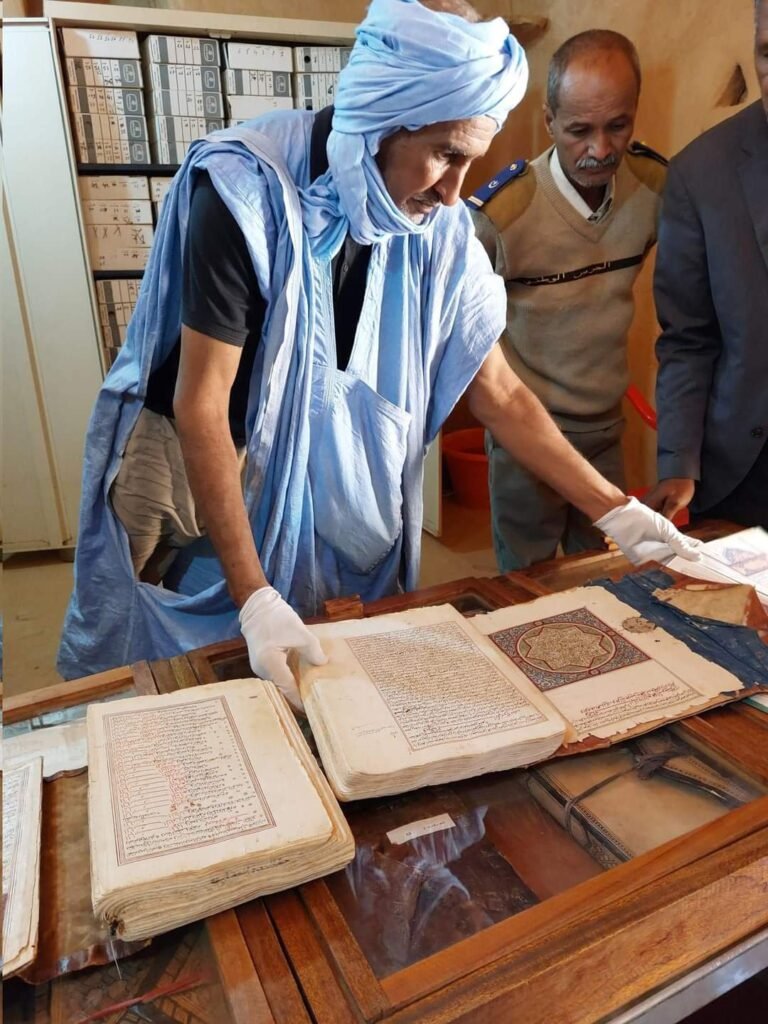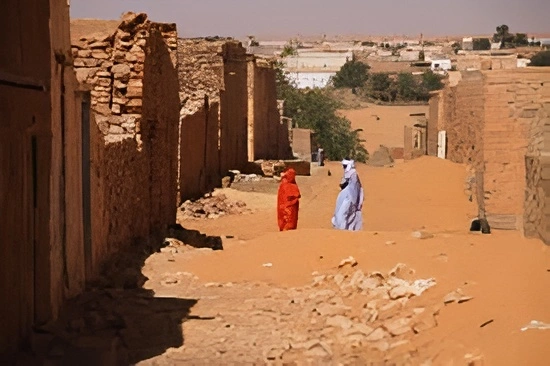Chinguetti Mosque, Mauritania, The City of Libraries of Faith
Chinguetti lies nestled amid the golden dunes of Mauritania’s Adrar Plateau and has become widely recognised as “The City of Libraries”, providing an oasis of faith, scholarship, and endurance in the harsh Sahara desert environment. Once known as a place for scholars due to its iconic mosque at its centre, this oasis once attracted scholars, traders, and pilgrims, as well as scholars travelling long distances for knowledge. Here, we explore the rich legacy of Chinguetti: its founding and golden era; the architecture of its historic mosque; remarkable libraries; threats it faces today, and how its significance continues to expand among modern societies.

Origins and the Rise of a Desert Scholarly City
Chinguetti’s story spans centuries of Saharan trade and Islamic learning. Situated on the Adrar Plateau in northern Mauritania, the city is among the oldest settled places in its region.
By the 11th-13th centuries, it had become a significant stop along trans-Saharan caravan routes, connecting gold and salt from West Africa to North Africa and beyond. Over generations, its inhabitants amassed extensive collections of manuscripts covering topics as diverse as religion, law, mathematics, astronomy, medicine, and poetry. It earned itself the poetic moniker “City of Libraries”.
At the same time, Chinguetti expanded as a centre of spiritual life: pilgrims, students, and scholars began converging here to worship; some traditions even consider Chinguetti one of Islam’s seven “holy cities.”
The Mosque: Architecture, Symbolism & Function
At the centre of Chinguetti lies its signature mosque — commonly referred to as “Friday Mosque” or the “Great Mosque”.
Construction & style
The mosque dates to either the 13th or 14th century and features locally produced split stone masonry with a clay mortar roof supported by palm wood beams that reflect the Saharan environment. Inside is a four-aisled prayer hall with a double niche mihrab (niche used to indicate direction towards Mecca that may include a minbar), which provides directionality and provides shade during prayer services.
Minarets & Symbolism
One of the most striking elements of any mosque is the square minaret. According to some sources, it may even be one of the oldest continuously used by Muslims around the world. Locally, this particular minaret features an ostrich egg finial design in line with Mauritanian architectural iconography.
Function & spiritual significance
Beyond serving as a place of worship, mosques served as places for learning and pilgrimage. Their presence symbolised both desert trading post and intellectual retreat – two characteristics embodied by Mauritanian society today. Today, it serves as both national emblem and testament of survival in its desert environment.
Libraries of the Desert – Chinguetti’s Intellectual Legacy

- Chinguetti stands out not only due to its mosque, but also for its libraries containing private collections of manuscripts documenting centuries of Islamic scholarship in West Africa.
- These manuscripts, often made of goat or gazelle skin parchment, cover an array of topics:
- Islam: Exploration of Its Jurisprudence and Theology
- Math, Geometry, Astronomy, and Medicine all go together.
- Mysticism and Poetry
Chinguetti gained international acclaim through its intellectual tradition of mysticism and poetry, earning the city its name far beyond its remote desert location. Its narrow lanes once led to “Rue des Savants,” where scholars from around the globe would exchange knowledge. Many manuscript libraries remain held by local families today but have become more vulnerable over time and to the climate

Architecture and Urban Fabric in a Harsh Environment
- Chinguetti’s built environment has been carefully tailored to its desert setting. The old town, constructed of sandstone and mud-brick with narrow streets, thick stone walls, and shallow windows – all strategies used to combat heat, wind, and sand – is compacted tightly, sheltering one another while creating shaded alleyways to reduce direct sunlight. Palm-wood beams support roofs while courtyards offer airflow and privacy.
- The city is divided by a dry wadi (riverbed), into old and new quarters that showcase layers of settlement and adaptation over time. Its main mosque represents this style in all of its purest form with its austere lines, minimal ornamentation, and geometric clarity – it epitomises desert architecture at its finest!
Trade, Knowledge, and Trans-Saharan Networks
- Chinguetti’s desert location belies its historical importance; from the 12th to 17th centuries, it played a pivotal role in connecting sub-Saharan Africa with North Africa and Mediterranean Europe via caravan routes.
- Chinguetti served as a hub in an otherwise barren landscape, where caravans of camels would gather. Here, caravans brought salt from the Sahara, gold from West Africa, leather textiles, and manuscripts, and leather was exchanged. Chinguetti helped spread Islam and learning throughout wide distances through Ouadane, Tichitt, and Oualata; its unique combination of commerce, faith, and scholarship created an invaluable network
Preservation, Threats, and Revival
- Though timeless in many respects, Chinguetti does not stand immune from change — or Threats
- Desertification poses one of the greatest dangers to cities today. Dunes have slowly crept closer to urban centres while wind-blown sand infiltrates homes and manuscripts alike; climate change only compounds this problem further.
Preservation efforts
In 1996, the “Ancient Ksour of Ouadane, Chinguetti, Tichitt and Oualata“ was designated a UNESCO World Heritage Site. Conservationists are digitizing manuscripts, training local restorers, and creating climate-controlled enclosures for fragile texts. Additionally, efforts in relation to traditional building techniques, urban management, and sand stabilization are underway.
Hope and resilience
Though their city faces significant challenges, its residents remain proactive: tree planting drives aim to anchor dunes while tourism provides economic support for heritage sites. Today, visitors will not find an isolated museum but instead will encounter an ongoing community that honors both past and future.

Visiting Chinguetti: Practical and Reflective Tips
- Travellers intending to visit Chinguetti may benefit from taking note of some practical notes and reflections before their trip:
- Respect the sacred site: To ensure maximum functionality of the mosque, visitors should dress modestly and seek local guides as necessary for access.
- Respect the desert climate: Temperatures fluctuate and sandstorms may occur, so it is wise to be prepared (sun protection, water, and sturdy footwear are advisable).
- Explore Libraries: With permission, visit family-run manuscript collections — providing a fascinating window into centuries of knowledge.
FAQs
Why is the Chinguetti Mosque famous?
It is one of the oldest mosques still operating in West Africa, and its iconic square minaret holds great symbolic meaning for Mauritania’s national identity.
Why are Chinguetti libraries unique?
They preserve manuscripts written over centuries on diverse subjects – an indicator of West Africa’s intellectual reach before European colonialism took hold.
Can tourists safely visit the Chinguetti Mosque?
Yes – both the mosque and old town are open to visitors; however, access may be restricted in certain parts of each. A local guide is strongly advised.
